William Bacon's KIC8462852 Tabby's star Page Index

-
Johns Hopkins University (JHU) continues to pad its space community résumé with their interactive map, “The map of the observable Universe”, that takes viewers on a 13.7-billion-year-old tour of the cosmos from the present to the moments after the Big Bang. While JHU is responsible for creating the site, additional contributions were made by NASA, the European Space Agency, the National Science Foundation, and the Sloan Foundation.
ITunes: RSS: Video Podcast version: ITunes: RSS: What is Fraser's Watching Playlist:
<>
An exploration of the strange happenings at the star KIC 8462852 and what they might mean. My Patreon page: My Event Horizon talk show channel: Papers: " A 1,574-Day Periodicity of Transits Orbiting KIC 8462852", Sacco et al., 2018 (ABSTRCT)
A 1,574-Day Periodicity of Transits Orbiting KIC 8462852
Snakes Have Legs "John Michael Godier" Music: Cylinder Eight by Chris Zabriskie is licensed under a Creative Commons Attribution 4.0 license. Source: Cylinder Five by Chris Zabriskie is licensed under a Creative Commons Attribution 4.0 license. Source: Music in this video Learn more Listen ad-free with YouTube Premium Song Cylinder Eight Artist Chris Zabriskie Album Cylinder Eight Licensed to YouTube by YouTube Audio Library
<>
There seems to be a repeating pattern for Tabby's Star KIC 8462852 dips, however it continues to be mysterious. Gary Sacco has been working with Tabetha Boyajian to continue to watch the star closely. A 1574-DAY PERIODICITY OF TRANSITS ORBITING KIC 8462852 (PDF) KIC8462852 Faded at an Average Rate of 0.164±0.013 (PDF) Magnitudes Per Century From 1890 To 1989 00:00:00 Intro 00:00:37 Bio 00:01:26 Tabby’s star update 00:05:07 Collisional model 00:10:16 The habitable zone of Tabby’s Star 00:12:20 The usefulness of archiving 00:14:58 Future of KIC 00:21:42 The mystery of Tabby’s star 00:25:26 Infrared observations 00:28:26 Alien Megastructure idea 00:38:32 Flares Want to support the channel? Follow us at other places! : Patreon: Website Instagram: Music featured on Event Horizon Stelladrome Miguel Johnson Leersevere Aeriumambient
The
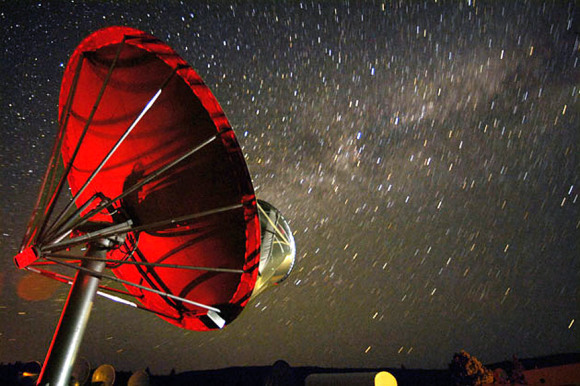
One of the 42 dishes in the Allen Telescope Array that will remain trained on KIC 8462852
through the end of next week gathering fresh data on the enigmatic star.
Credit: Seth Shostak / SETI Institute
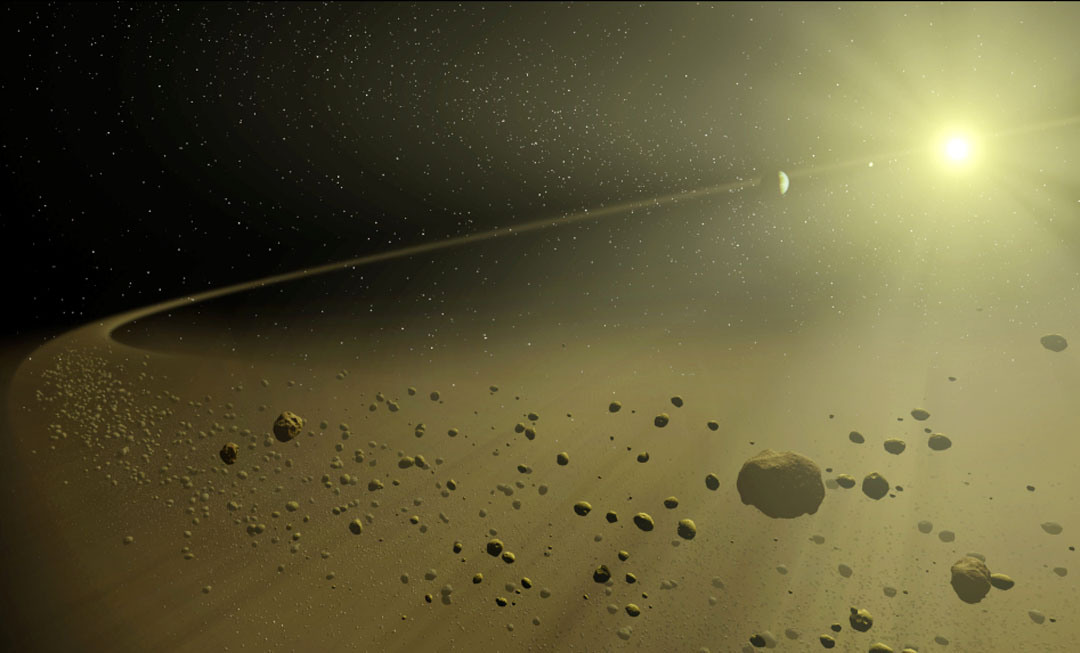
Something other than a transiting planet makes KIC 8462852 fluctuate wildly and unpredictably in brightness.
Astronomers suspect a crumbled comet, but the cause remains a mystery.
Credit: NASA
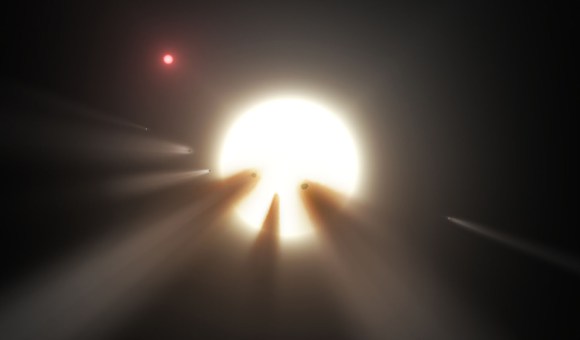
This illustration shows a star behind a shattered comet. Observations of the star KIC 8462852
by NASA’s Kepler and Spitzer space telescopes suggest that its unusual light signals are likely from dusty comet fragments,
which blocked the light of the star as they passed in front of it in 2011 and 2013. The comets are thought to be traveling
around the star in a very long, eccentric orbit.
Credit: NASA/JPL-Caltech
Here is a report on KIC 846252 has been fading!
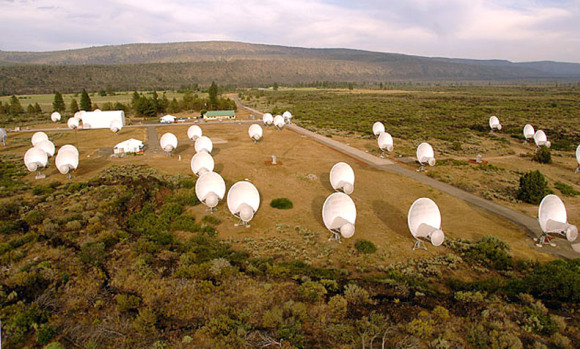
SThe Allen Telescope Array (ATA) is a “Large Number of Small Dishes†(LNSD) array designed to be highly effective
for simultaneous surveys undertaken for SETI projects (Search for Extraterrestrial Intelligence) at centimeter wavelengths.
Credit: Seth Shostak / SETI Institute
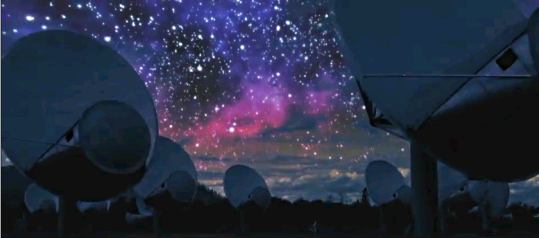
Radio observations were carried out from the Allen Telescope Array of the reputed megastructure-encompassed star KIC 8462852.
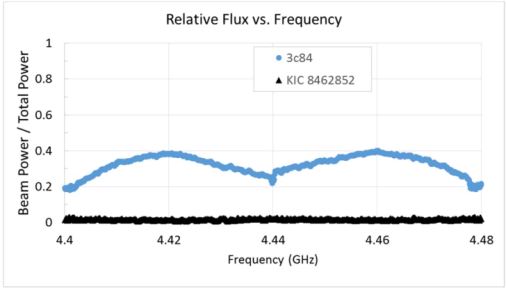
Fig 1 from Harp et al. (2015) conveys the lack of radio waves emerging from the star KIC 8462852 (black symbols),
however there were sensitivity and coverage limitations (see text). The signal emerging from the quasar 3c84 is shown via blue symbols.
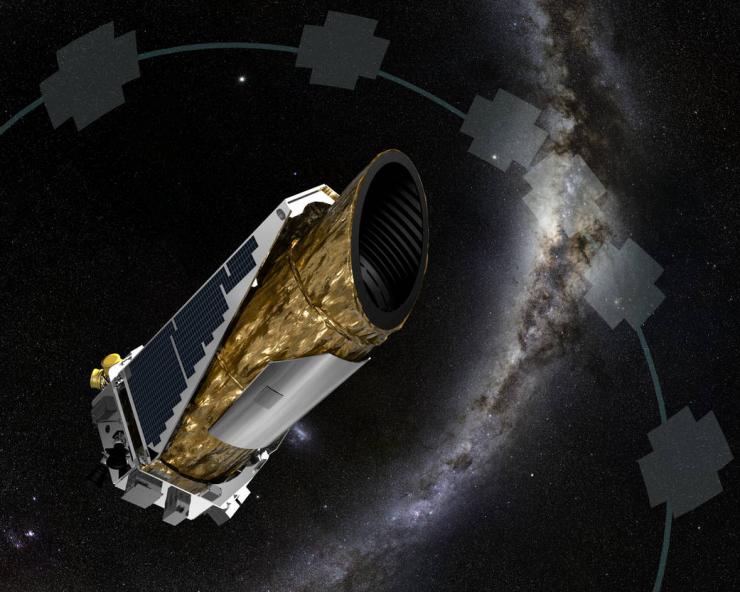
The hunt for an alien megastructure has made for sensational headlines, but what are the chances of finding something?
Pictured is an artist's impression of Kepler, the spacecraft that observed the distant star KIC 8462852.
NASA Ames/JPL-Caltech/T Pyle

However, alien enthusiast claim that the alien civilization might be advanced enough to use other means
of communication than laser pulses and radio waves, so they're still holding out hope that E.T. might be in our vicinity.
A mysterious star that erratically dims by almost a quarter as a swarm of unknown objects passes in front of it -
leading to speculations that artificial objects could be orbiting the star - continues to refuse to give up its secrets
after a search for laser pulses from the system turned up empty.
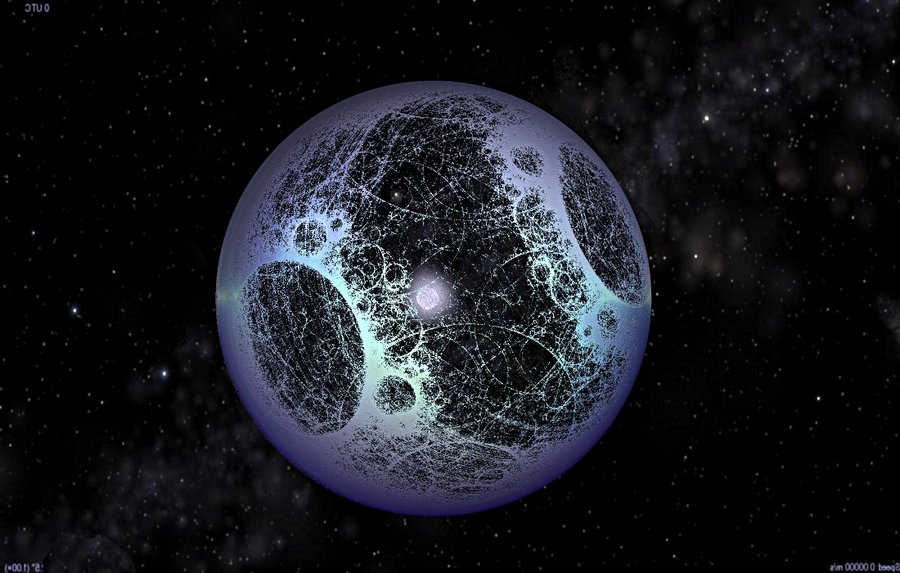
Ever since it was first announced in 2015, there has been speculation as to what could account for the dimming of KIC 8462852.(artist Concept) Credit:Sentient Developments.com
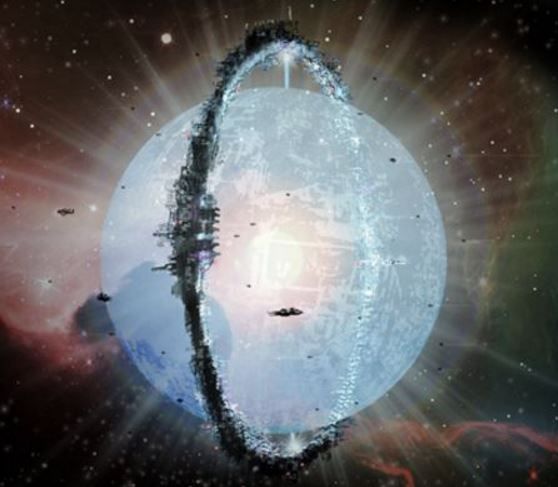
Another theory on Tabby's Star
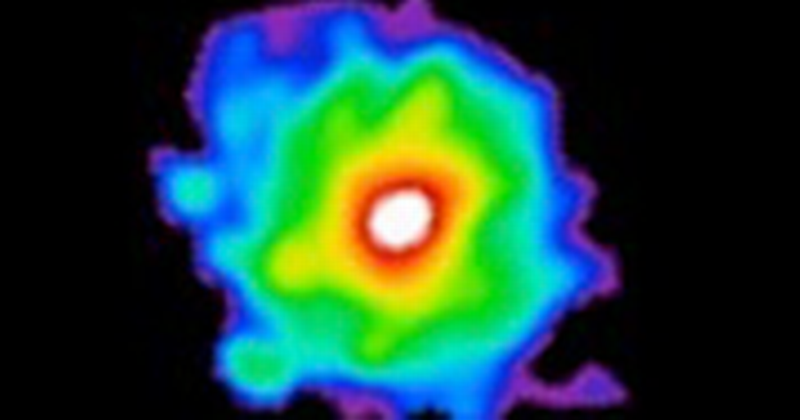
Even if aliens are not involved, Tabby's star remains "the most mysterious star in the universe"
as Yale astronomer Tabetha Boyajian described it in a TED talk she gave last February.
"The dips found by Kepler are real. Something seems to be transiting in front of this star
and we still have no idea what it is!" says German astronomer Michael Hippke.
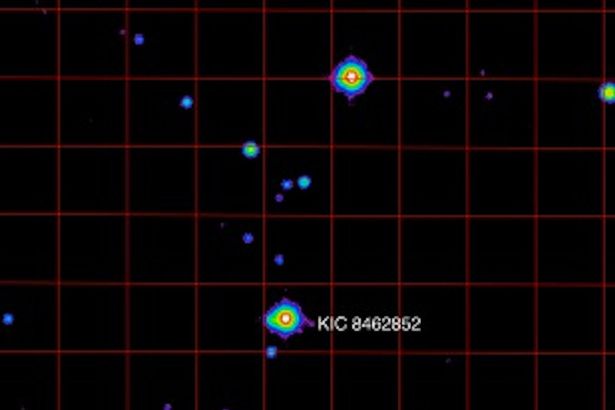
The most remarkable of these fluctuations consisted of dozens of uneven, unnatural-looking dips
that appeared over a 100-day period indicating that a large number of irregularly shaped objects
had passed across the face of the star and temporarily blocked some of the light coming from it.
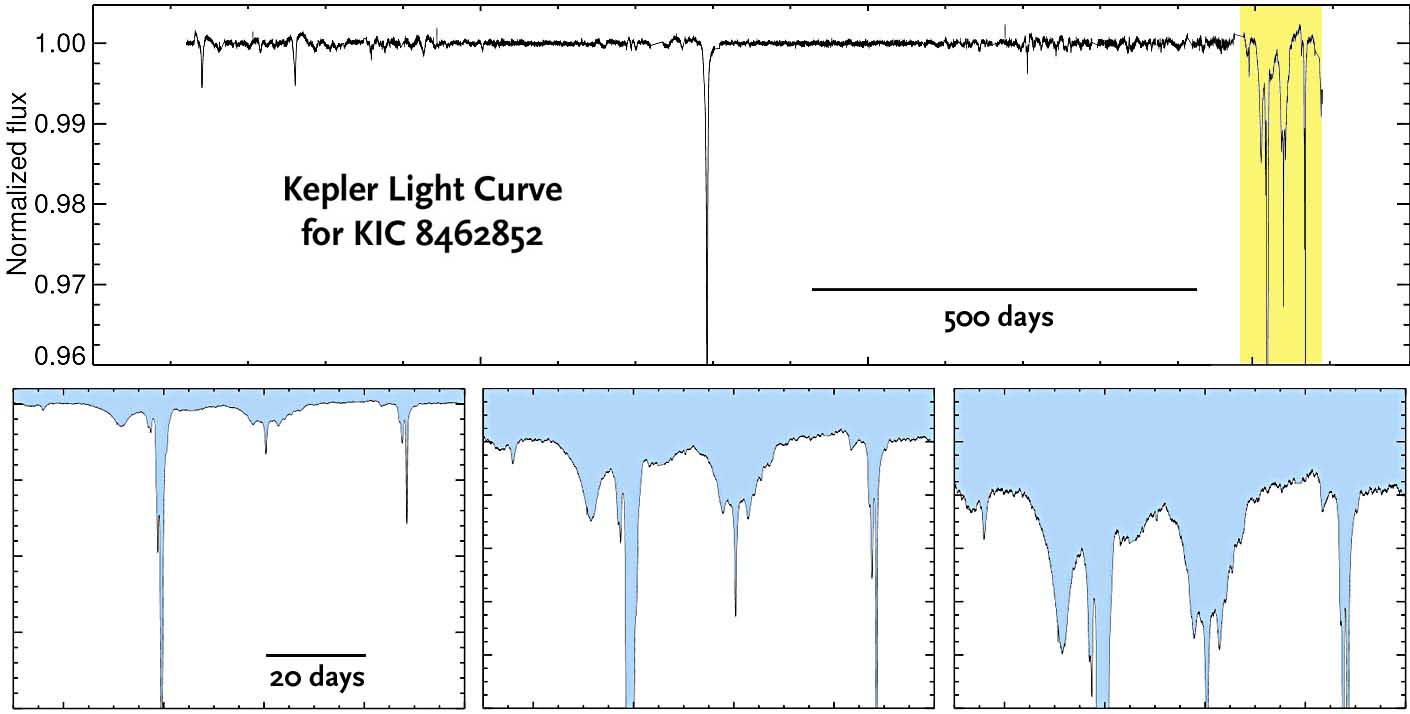
The attention caused scientists at the SETI Institute to train its Alien Telescope Array
on the star to see if they could detect any radio signals indicating the presence of an alien civilization.
In November, 2015 it reported finding "no such evidence" of signals with an artificial origin.
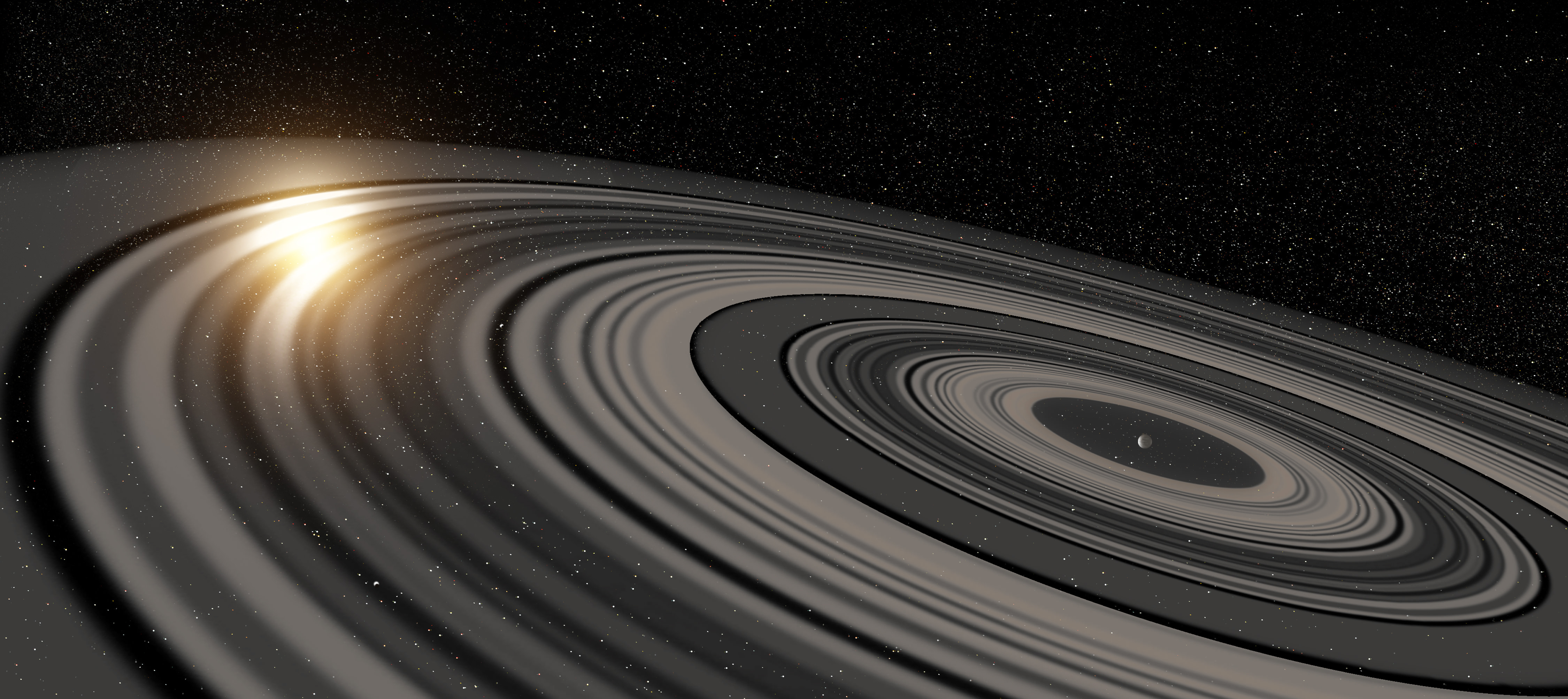
Artist's impression of a gigantic ring system around a distant exoplanet. Credit and ©: Ron Miller
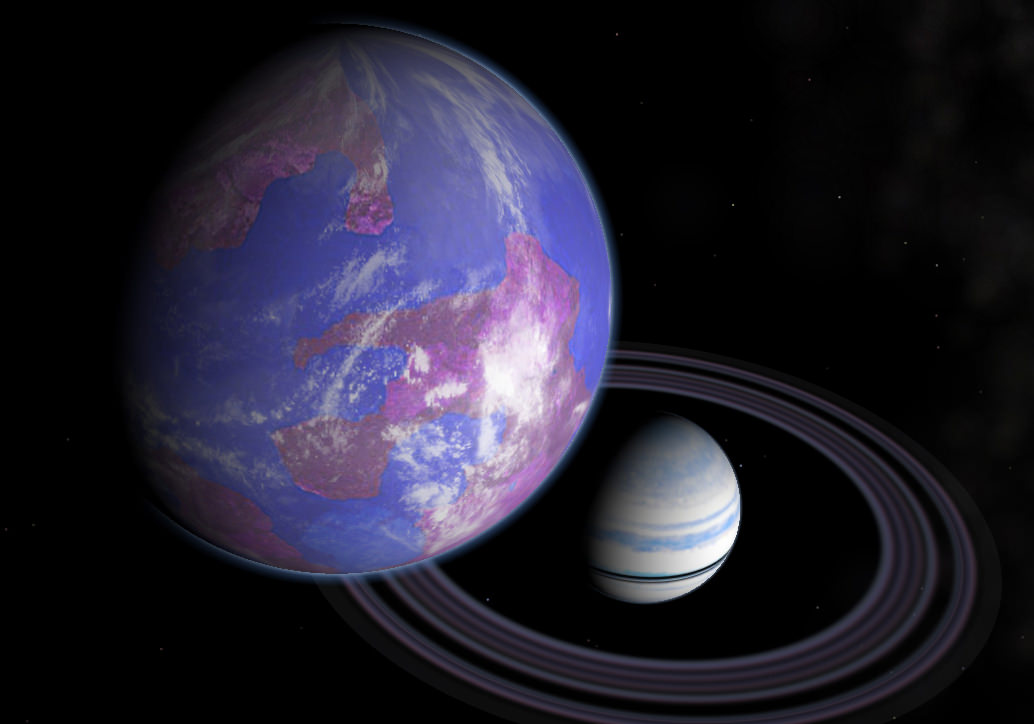
An artist impression of an exomoon orbiting a ringed exoplanet. Credit: Andy McLatchie
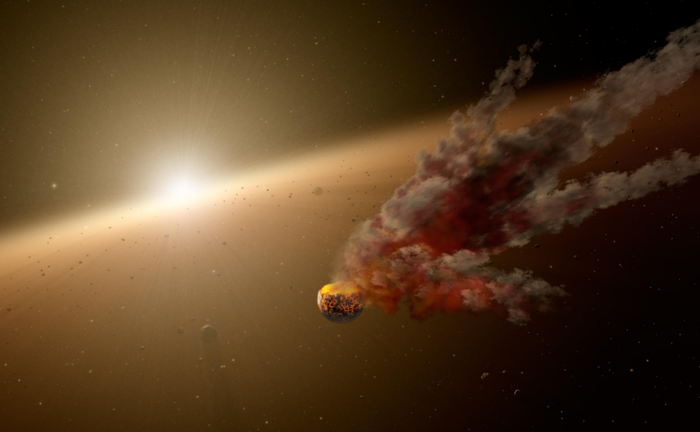
Artist's concept of KIC 8462852, which has experienced unusual changes in luminosity over the past few years.
Credit: NASA, JPL-Caltech
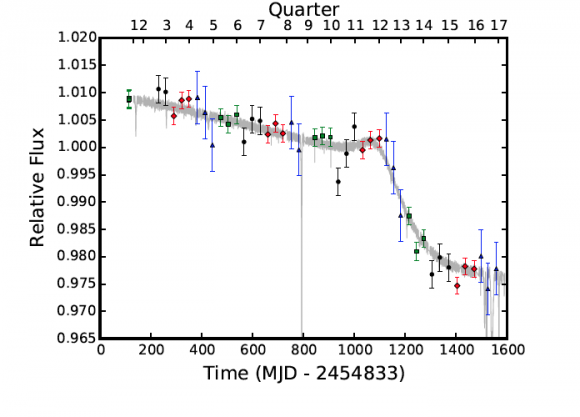
Photometry of KIC8462852 obtained by the Kepler mission, showing a period of more rapid
decline during the later period of observation. Credit: Montet & Simon 2016 As Dr. Montet told Universe Today via email: “Every 30 minutes, Kepler measures the brightness of 160,000 stars in its field of view (100 square degrees,
or approximately as big as your hand at arm’s length). The Kepler data processing pipeline intentionally removes long-term trends,
because they are hard to separate from instrumental effects and they make the search for planets harder.
Once a month though, they download the full frame, so the brightness of every object in the field can be measured.
From this data, we can separate the instrumental effects from astrophysical effects by seeing how the brightness of any
particular star changes relative to all its neighboring stars.â€
Published on Aug 4, 2016 A in-depth look at KIC 8462582, also known as Tabby's Star. We'll explore how this star became
famous for an anomaly, what that anomaly was, and the various theories for what might be causing it. Listen or Download the audio of this episode from Soundcloud Support the Channel on Patreon: Cover Art by Jakub Grygier: Recent Developments: 5 Aug 2016 some new research came out the same day as the video, in terms of the overall dimming, Paul Gilster discusses it here, and Centauri Dreams is an excellent place to keep up on new developments as they occur: Category Science & Technology License Standard YouTube License
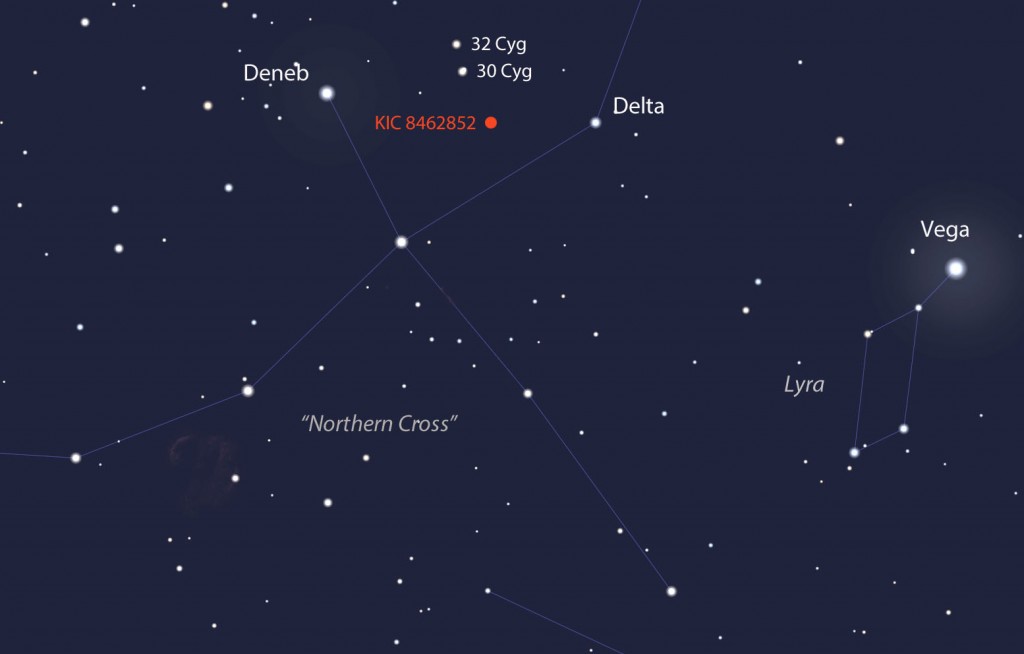
Tabby’s Star shines at magnitude +11.7 in the constellation Cygnus the Swan (Northern Cross) high in the southwestern sky at nightfall
in late October. A 6-inch or larger telescope will easily show it.
Source: Stellarium

Artist's concept of KIC 8462852, which has experienced unusual changes in luminosity over the past few years.
Credit: NASA, JPL-Caltech
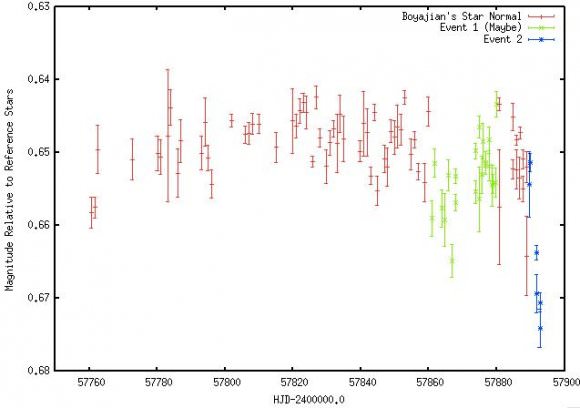
Preliminary analysis of incoming data of KIC 8462852, showing the apparent dip. Credit: Matthew Muterspaugh/Tennessee State University/CEISEM
Streamed live on May 19, 2017 Tabby's Star (aka the WTF (Where's the Flux) Star, Boyajian's Star, the Most Mysterious Star in the known Universe) is entering another of its irregular dips. Here at UC Berkeley SETI we're lucky to have Prof. Jason Wright visiting this week. Join him and Berkeley SETI Director Dr. Andrew Siemion at 11 Pacific for live updates. Tweet your questions @BerkeleySETI. Category Science & Technology License Standard YouTube License
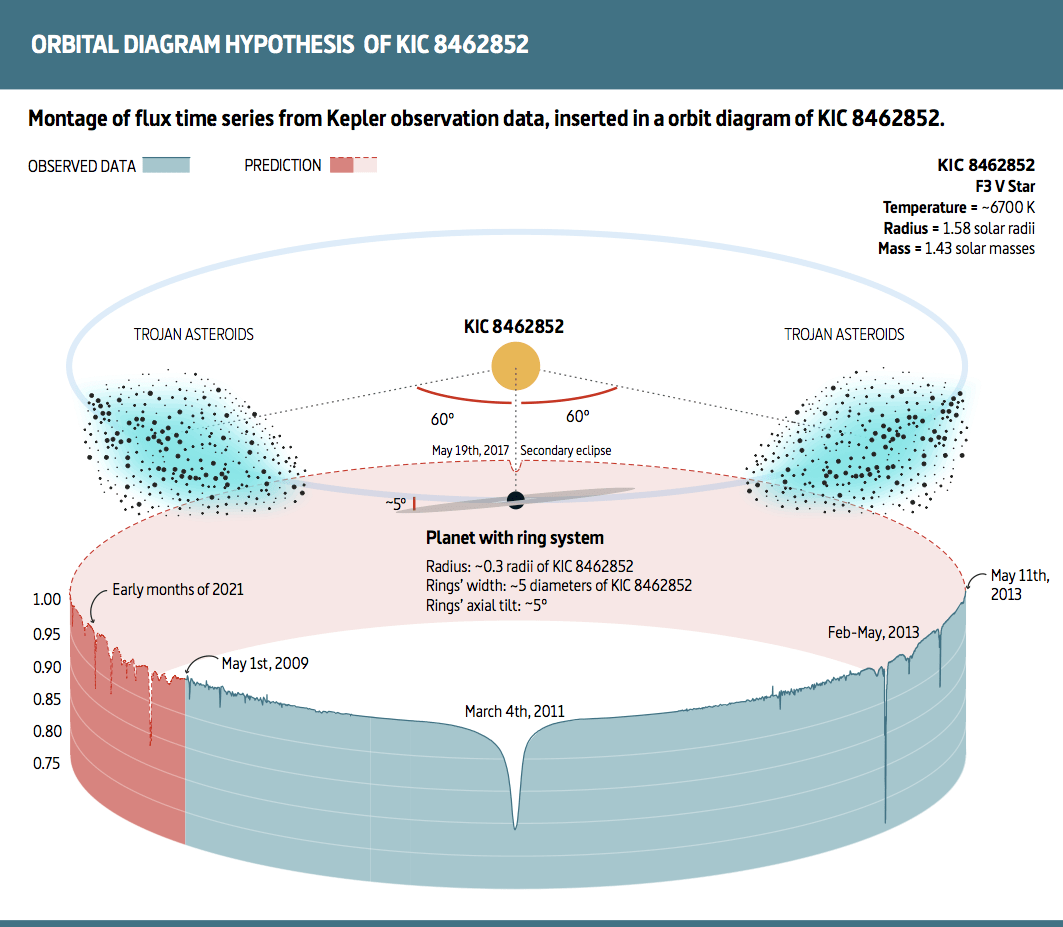
Diagram of the KIC 8462852 system, showing the possible influence of Trojans on its brightness. Credit: F. Ballesteros et al.
“Whereas most of the scenarios that have already been discussed by other authors invoke the presence of astronomical objects that have never been directly observed, from the comet clouds in Boyajian et al. (2016) to the Dyson sphere in Wright et al. (2016), our model requires the presence of relatively familiar objects, namely a large planet with orbiting rings and a cloud of Trojan asteroids. Moreover, our model allows us to make a definite prediction: the leading Trojan cloud should induce a new period of irregularities in the light curve approximately in 2021.†Jason Wright's Website
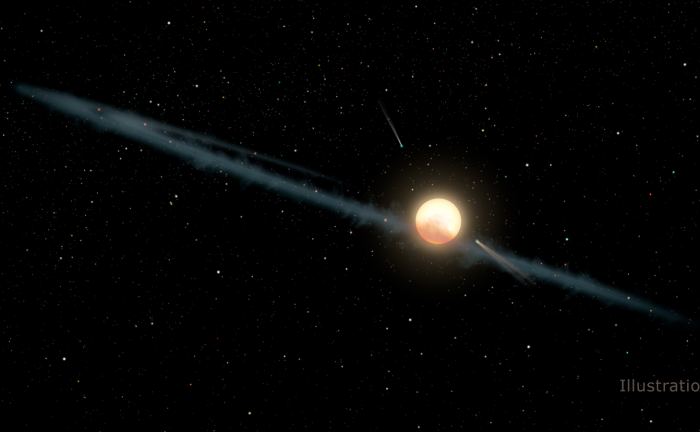
This illustration depicts a hypothetical uneven ring of dust orbiting KIC 8462852, also known as Boyajian's Star or Tabby's Star. Credit: NASA/JPL-Caltech
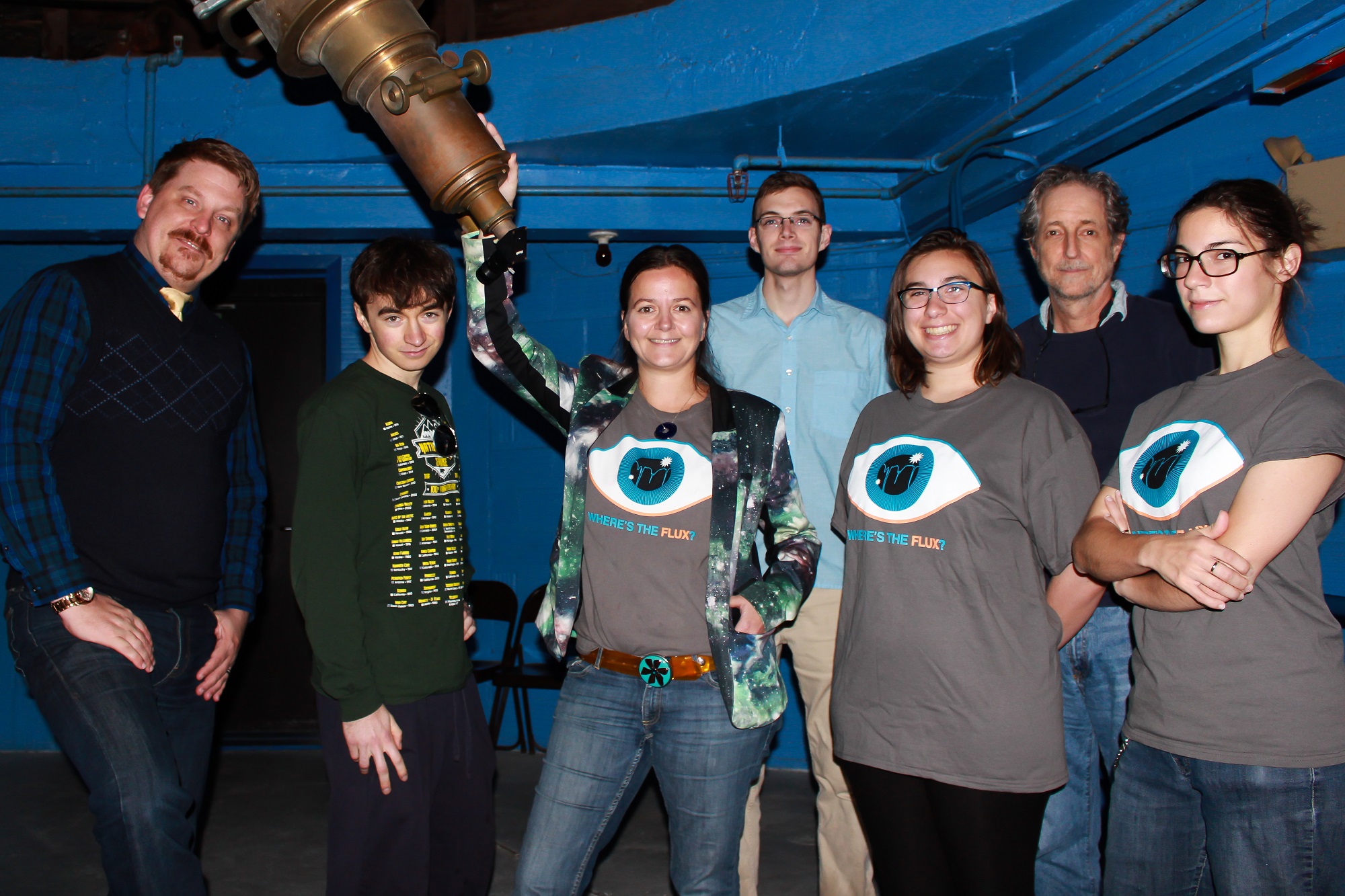
LSU Astronomer Tabetha Boyajian (center) and her students and research staff. (Left to right) Robert Parks, undergraduate student Rory Bentley, Assistant Professor Tabetha Boyajian, PhD candidate Tyler Ellis, undergrad Katie Nugent, Professor Geoff Clayton and graduate student Emily Safron. Credit: LSU
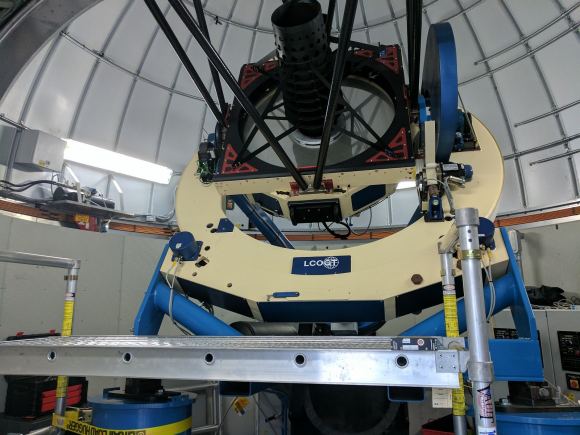
One of the many robotic telescopes part of the Las Cumbres Observatory used to observe Tabby’s Star. Credit: LSU
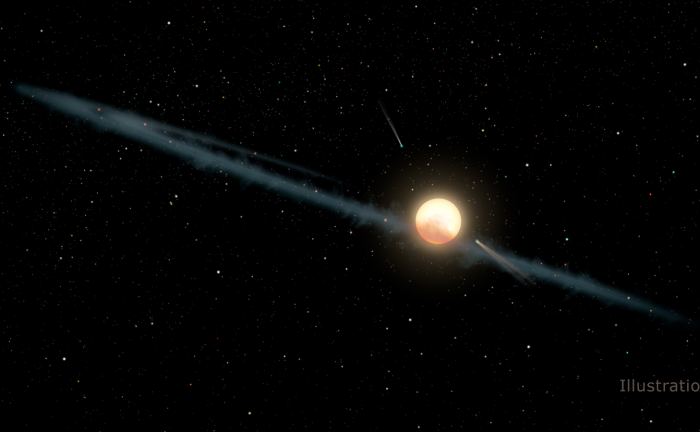
This illustration depicts a hypothetical uneven ring of dust orbiting KIC 8462852, also known as Boyajian's Star or Tabby's Star. Credit: NASA/JPL-Caltech
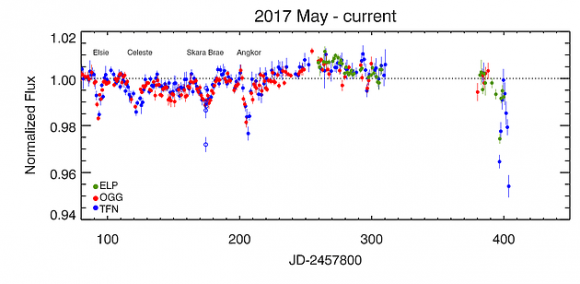
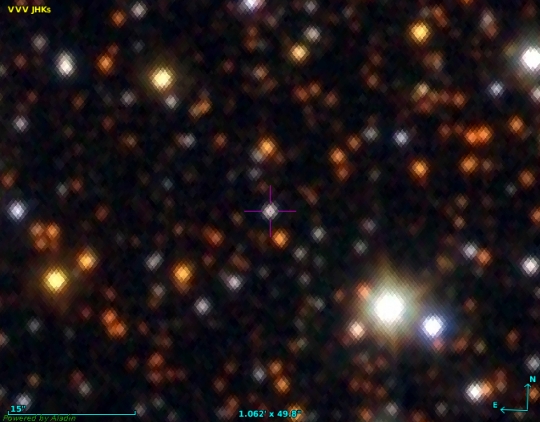
Image: VVV-WIT-07 in the centre of a star field. Credit: Saito et al. This is fertile ground for discovery, but even so, the object known as VVV-WIT-07 is taking everyone a bit by surprise. We’re dealing with a star that reminds everyone of Boyajian’s Star (KIC 8462852), famed for its unusual dips in lightcurve. Were they signs of a Dyson Sphere under construction, or a natural phenomenon the likes of which we had never seen? Uneven rings of dust, dusty planetesimals or comets are still in contention. Now we have a star that is apparently even more extreme, one whose range in lightcurve variation is extraordinary. Viewed by the survey over a period of eight years, VVV-WIT-07 has been seem to dim first by a factor of 2, then by almost 80 percent. A week later, it was back to normal.
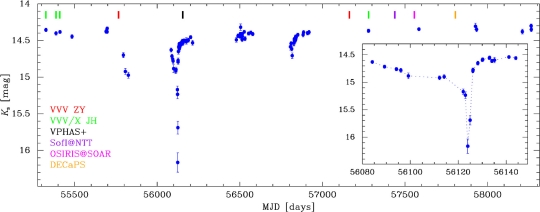
Image: Lightcurve of VVV-WIT-07 showing how it varied in brightness between 2010 and 2018. The insert shows an expanded view of the particularly dramatic dimming event that occurred in July 2012. Credit: Saito et al. Is it possible we are looking at some kind of circumstellar disk with huge variations in it, a clumpy disk that blocks the star’s light in this highly irregular way? The odds on that seem long. Here is what the paper says: Alternative scenarios for VVV-WIT-07 include a “dipper” T Tauri star with clumpy dust structures orbiting in the inner disk that transit our line of sight (e.g. Rodriguez et al. 2017), or even a long period, high-inclination X-ray binary. The deep, narrow eclipse delayed with respect to a broad and shallower dip is reminiscent of the morphology seen in high-inclination low-mass X-ray binaries (LMXB, e.g. Parmar et al. 1986; Baptista et al. 2002). However, LMXBs are restricted to orbital periods of less than a few days while high-mass x-ray binaries (HMXB) can be found at Porb up to hundreds of days (e.g. X1145-619 has Porb = 187.5 d, Watson et al. 1981). Moreover, in this scenario optical and IR spectra would be dominated by the mass-donor companion star, and should show rotationally-broadened hydrogen absorption lines at epochs of no mass ejection episodes, which is not the seen in the spectra of VVV-WIT-07.
Gary Sacco has been working with Tabetha Boyajian to continue to watch the star closely. As well, in 2017 Gary was the lead author on a paper predicting A 1574-DAY PERIODICITY OF TRANSITS ORBITING KIC 8462852, and that prediction seems to be correct with the new dip observed on September 10th. A 1574-DAY PERIODICITY OF TRANSITS ORBITING KIC 8462852 (PDF) KIC8462852 Faded at an Average Rate of 0.164±0.013 (PDF)
Magnitudes Per Century From 1890 To 1989 Instagram 00:00:00 Intro 00:00:37 Bio 0:01:17 Tabby’s star is dimming again 0:07:55 The habitable zone of KIC 0:11:00 Tiny dust 00:12:57 The Secular dimming issue 00:16:09 Are the two types of dimming related? 00:18:06 Planet Sized Comets and the Alien question 00:24:00 UAPs… 00:28:00 UAPs as machines 00:33:00 Back to Tabby’s Star 00:33:26 More intrigue coming… 00:44:15 An Alien in John’s Studio! Want to support the channel? Follow us at other places! : Patreon: Website Instagram: Music featured on Event Horizon Stelladrome Miguel Johnson Leersevere Aeriumambient FOOTAGE: NASA ESA/Hubble ESO - M.Kornmesser ESO - L.Calcada ESO - Jose Francisco Salgado (josefrancisco.org) NAOJ University of Warwick Goddard Visualization Studio Langley Research Center Pixabay #KIC8462852 #AlienMegaStructureStar
This week astronomers announced an unusual transit signal from another star. Although it’s most
likely a natural phenomenon, one remote possibility is that this is some kind of alien megastructure.
Freeman Dyson and others have considered this idea for decades. Today we’ll talk about the kinds of structures
that aliens might want to build.
Published on Aug 18, 2014 Visit for more. Astronomers are not only discovering planets around distant suns, they are also starting
to measure those worlds with astonishing precision. The diameter of a super-Earth named Kepler-93b is
now known to within an accuracy of 148 miles. Category Science & Technology License Standard YouTube License
Prof Jason Wright from Penn State explains why Tabby's Star has become known as the most mysterious star in the galaxy and how you can help him and Tabby Boyajian solve this mystery. To contribute to their Kickstarter campaign, go to https://www.kickstarter.com/projects/... right now! ::More about this Video:: ► Kickstarter page: Where's the Flux?": ► Boyajian et al. (2016), "Planet Hunters X. KIC 8462852 - ► Wright et al. (2016), "The Ĝ Search for Extraterrestrial Civilizations with Large Energy Supplies. IV.: The Signatures and Information Content of Transiting Megastructures" ► Prof Wright's blog, AstroWright: ► Dr Tabetha Boyajian's TED talk: :► Outro music by Taylor Davis ::Playlists For Channel:: Latest Cool Worlds Videos ►<.A> Cool Worlds Research ► Guest Videos ► Q&A Videos ► Science of TV/Film ► ::Follow us:: SUBSCRIBE to the channel Cool Worlds Lab Twitter Instagram THANKS FOR WATCHING!! Category Science & Technology License Standard YouTube License SHOW LESS
Something massive, with roughly 1,000 times the area of Earth, is blocking the light coming from a distant star known as KIC 8462852, and nobody is quite sure what it is. As astronomer Tabetha Boyajian investigated this perplexing celestial object, a colleague suggested something unusual: Could it be an alien-built megastructure? Such an extraordinary idea would require extraordinary evidence. In this talk, Boyajian gives us a look at how scientists search for and test hypotheses when faced with the unknown. TEDTalks is a daily video podcast of the best talks and performances from the TED Conference, where the world's leading thinkers and doers give the talk of their lives in 18 minutes (or less). Look for talks on Technology, Entertainment and Design -- plus science, business, global issues, the arts and much more. Find closed captions and translated subtitles in many languages at Follow TED news on Twitter: : Like TED on Facebook :Subscribe to our channel
Prof Jason Wright from Penn State explains why Tabby's Star has become known as the most mysterious star in the galaxy and how you can help him and Tabby Boyajian solve this mystery. go to To contribute to their Kickstarter campaign, ::More about this Video:: :► Kickstarter page ► Boyajian et al. (2016), "Planet Hunters X. KIC 8462852 - Where's the Flux? (PDF)": ► Wright et al. (2016), "The Ĝ Search for Extraterrestrial Civilizations with Large Energy Supplies. IV. The Signatures and Information Content of Transiting Megastructures (pdf)": ► Prof Wright's blog, AstroWright: ► Dr Tabetha Boyajian's TED talk:
â–º Outro music by Taylor Davis:
::Playlists For Channel:: Latest Cool Worlds Videos â–º Cool Worlds Research â–º Guest Videos â–º Q&A Videos â–º Science of TV/Film â–º ::Follow us:: SUBSCRIBE to the channel Cool Worlds Lab Twitter Instagram
The first image of the what tabby's star looks like. The alien megastructure star KIC 8462852 tabby's star has been closely studied for an object dimming it. Using 1D data points to create a 2D image to reconstruct an image of whatever it is that causes the dimming of Tabby's star, by Dr. David Kipping and Emily Sandford of Columbia University. Joining John Michael Godier is David Kipping the Assistant Professor of Astronomy at Columbia University, where he researches extrasolar planets and moons. Dr. Kipping his team at the Cool Worlds Lab at Columbia, includes a Youtube channel and website where you can learn more about their research. ► Sandford & Kipping (2019), "Shadow Imaging of Transiting Objects", Astronomical Journal, accepted ► Background to Tabby's Star by Jason Wright: ► Our live Q&A with Tabby Boyajian: ► "Just a Dust Bowl?" update video on Tabby's Star: ► "A Theory for Tabby's Star (Without Aliens)" video: ► Boyajian et al. (2016), "Planet Hunters X. KIC 8462852 - Where's the Flux?": ► Bodman et al. (2018) "The Variable Wavelength Dependence of the Dipping event of KIC 8462852">► "The Variable Wavelength Dependence of the Dipping event of KIC 8462852": Outro music "Sad Game Boy" by Mikey Geiger, licensed through ► Bodman et al. (2018) ► Columbia University Department of Astronomy: ► Cool Worlds Lab website: ::Playlists For Channel:: Latest Cool Worlds Videos ► Cool Worlds Research ► Guest Videos ► Q&A Videos ► Tabby's Star ► Science of TV/Film ►
Boyajian's Star (Tabby's Star) has mystified us since we first saw those bizarre dimmings recored by NASA's Kepler Mission. Over the years, people have shown that the data could be explained by comets, or planet engulfement, or even alien megastructures. But here at the Cool Worlds Lab, we had a different idea. Rather than propose a specific hypothesis and see how well it matches the data, why not use the data to reconstruct an image of whatever it was that caused the dimming? Sounds simple, right? Well it took us about two years to crack this damn problem but we're thrilled to finally discuss it with you all in this Cool Worlds exclusive! ► Sandford & Kipping (2019), "Shadow Imaging of Transiting Objects", Astronomical Journal, accepted ► Background to Tabby's Star by Jason Wright: ► Our live Q&A with Tabby Boyajian: ► "Just a Dust Bowl?" update video on Tabby's Star: ► "A Theory for Tabby's Star (Without Aliens)" video: ► Boyajian et al. (2016), "Planet Hunters X. KIC 8462852 - Where's the Flux?": ► Bodman et al. (2018) "The Variable Wavelength Dependence of the Dipping event of KIC 8462852">► "The Variable Wavelength Dependence of the Dipping event of KIC 8462852": Outro music "Sad Game Boy" by Mikey Geiger, licensed through ► Bodman et al. (2018) ► Columbia University Department of Astronomy: ► Cool Worlds Lab website: ::Playlists For Channel:: Latest Cool Worlds Videos ► Cool Worlds Research ► Guest Videos ► Q&A Videos ► Tabby's Star ► Science of TV/Film ►
<>
recent paper: - - For a long time, extraterrestrial megastructures have piqued the interest of many experts and amateur astronomers. Tabby's star was one such huge draw. The strange lowering of light incident has sparked a flurry of speculation. Tabby's Star, also known as star KIC 8462852, has been a source of fascination and investigation in the scientific community for quite some time, with scientists attempting to discover why it experiences unpredictable episodes of brightening and fading. We talked about the strangeness of Tabby’s star in one of our previous videos with possible explanations of the weird dimming of light. But more strangeness seems to have emerged from the new data of Tabby’s star. Surprising evidence has been discovered that might help explain the enigma of this strangely fading star. So just sit back and relax while we explain to you the mysterious circumstances surrounding the star KIC 8462852 or Tabby’s star. NASA's Kepler mission has fundamentally altered the game when it comes to studying exoplanets and other distant worlds. It has observed around 530,000 stars to date. There are over 2600 undiscovered exoplanets. - - "If You happen to see any content that is yours, and we didn't give credit in the right manner please let us know at and we will correct it immediately" "Some of our visual content is under an Attribution-ShareAlike license. in its different versions such as 1.0, 2.0, 3,0, and 4.0 – permitting commercial sharing with attribution given in each picture accordingly in the video." Credits: Ron Miller, Mark A. Garlick / MarkGarlick.com Credits: Nasa/Shutterstock/Storyblocks/Elon Musk/SpaceX/ESA/ESO/ Flickr #InsaneCuriosity #tabbystar #boyajianstar
VVV-WIT-07: another Boyajian’s star or a Mamajek’s object?? (PDF)